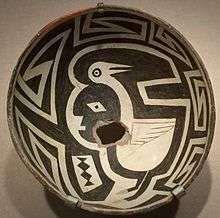Figure–ground (perception)


Figure–ground organization is a type of perceptual grouping which is a vital necessity for recognizing objects through vision. In Gestalt psychology it is known as identifying a figure from the background. For example, you see words on a printed paper as the "figure" and the white sheet as the "background".[1]
Examples
The most famous example of figure–ground perception is probably the faces–vase drawing that Danish psychologist Edgar Rubin described.[2][3] This drawing exemplifies one of the key aspects of figure–ground organization, edge-assignment and its effect on shape perception. Notice in the faces/vase drawing, the perceived shape depends critically on the direction in which the border (edge) between the black and white regions is assigned. If the two curvy edges between the black and white regions are assigned inward then the central white region is seen as a vase shape in front of a black background. No faces are perceived in this case. On the other hand, if the edges are assigned outwards, then the two black profile faces are perceived on a white background and no vase shape is perceived. The human visual system will then settle on either of the interpretations of the Rubin vase and alternate between them. Functional brain imaging shows that when people see the Rubin image as a face, there is activity in the temporal lobe, specifically in the face-selective region [4][5]
Perceptual process
How does the brain decide in a visual scene which item is the figure and which are part of the ground? This perceptual decision can be based on many cues, all of which are of a probabilistic nature. For instance, size helps us distinguish between the figure and the ground, since smaller regions are often (but not always) figures. Object shape can help us distinguish figure from ground, because figures tend to be convex. Movement also helps; the figure may be moving against a static environment. Color is also a cue, because the background tends to continue as one color behind potentially multiple foreground figures, whose colors may vary. Edge assignment also helps; if the edge belongs to the figure, it defines the shape while the background exists behind the shape. But it's at times difficult to distinguish between the two because the edge that would separate figure from ground is really part of neither, it equally defines both the figure and the background.[6]
Evidently, the process of distinguishing figure from ground (sometimes called figure–ground segmentation) is inherently probabilistic, and the best that the brain can do is to take all relevant cues into account in order to generate a probabilistic best-guess. In this light, Bayesian figure–ground segmentation models have been proposed to simulate the probabilistic inference by which the brain may distinguish figure from ground.[7][8]
Artistic applications
Figure–ground organization is used to help artists and designers in composition of a 2D piece. Figure–ground reversal may be used as an intentional visual design technique in which an existing image's foreground and background colors are purposely swapped to create new images.
Non-visual
Figure–ground perception can be expanded from visual perception to include abstract (i.e. non-visual) concepts such as melody/harmony, subject/background and positive/negative space. The concept of figure and ground fully depends on the observer and not on the item itself.[9]
Types of figure–ground problems

There are three types of figure–ground problems:
- The figure and the ground compete.
- The figure should be the ground and the ground should be the figure.
- The figure and ground create an optical illusion.[10]
See also
References
- ↑ Schacter, Daniel L., Daniel T. Gilbert, and Daniel M. Wegner. "Chapter 4: Sensation and Perception, Vision II: Recognizing What We Perceive." Psychology. ; Second Edition. N.p.: Worth, Incorporated, 2011. 149-50. Print.
- ↑ Rubin, E. (1921) Visuell Wahrgenommene Figuren : Studien in psychologischer Analyse. Kobenhaven: Gyldendalske boghandel.
- ↑ Rubin, E. (2001). Figure and Ground. In Yantis, S.(Ed.), Visual Perception. (pp. 225-229). Philadelphia, Psychology Press
- ↑ Schacter, L.D., Gilbert, D.T., Wegner, D.M. (2011). "Psychology (2nd ed.)." New York, NY: Worth Publishers
- ↑ Hasson, U., Hendler, T., Ben Bashat, D., and Malach, R. (2001). Vase or face? A neural correlate of shape-selective grouping processes in the human brain. J. Cogn. Neurosci. 13, 744–753.
- ↑ Schacter, Daniel L.; Daniel T., Gilbert; Daniel M., Wegner (March 2011). Psychology: Second Edition. United States of America: Worth Publishers. p. 149. ISBN 1-4292-3719-8.
- ↑ Goldreich, D; Peterson, MA (2012). "A Bayesian observer replicates convexity context effects in figure–ground perception.". Seeing and perceiving. 25 (3-4): 365–95. doi:10.1163/187847612X634445. PMID 22564398.
- ↑ Barghout, L; Lee, L (2003). "Perceptual information processing system.". USPatent Patent Application 10/618,543,.
- ↑ Carlson, Neil R (2010). Psychology the science of behaviour-figure and ground. USA: Pearson Canada. p. 175. ISBN 978-0-205-64524-4.
- ↑ Lohr L. Creating Graphics for Learning and Performance: Lessons in Visual Literacy Cleveland, OH: Prentice-Hall, 2007.
External links
- Figure Ground, a puzzle game plays on the figure–ground illusion.